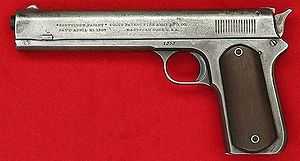.38 ACP
| .38 ACP |
|---|
 |
| Type |
Pistol |
|---|
| Place of origin |
USA |
|---|
| Production history |
|---|
| Designer |
John Browning |
|---|
| Designed |
1900 |
|---|
| Manufacturer |
Colt |
|---|
| Specifications |
|---|
| Case type |
Semi-rimmed, straight |
|---|
| Bullet diameter |
.356 in (9.0 mm) |
|---|
| Neck diameter |
.384 in (9.8 mm) |
|---|
| Base diameter |
.384 in (9.8 mm) |
|---|
| Rim diameter |
.406 in (10.3 mm) |
|---|
| Rim thickness |
.050 in (1.3 mm) |
|---|
| Case length |
.900 in (22.9 mm) |
|---|
| Overall length |
1.280 in (32.5 mm) |
|---|
| Primer type |
Small pistol |
|---|
| Ballistic performance |
|---|
| Bullet weight/type |
Velocity |
Energy |
| 115 gr (7 g) FMJ |
1,150 ft/s (350 m/s) |
338 ft·lbf (458 J) |
| 125 gr (8 g) JHP |
1,100 ft/s (340 m/s) |
336 ft·lbf (456 J) |
| 130 gr (8 g) FMJ |
1,040 ft/s (320 m/s) |
312 ft·lbf (423 J) |
|
|
Source(s): Cartridges of the World[1] |
The .38 ACP (Automatic Colt Pistol) also known as the .38 Auto was introduced at the turn of the 20th century for the Browning designed Colt M1900. The cartridge headspaces on the rim.[2] It had first been used in Colt's Model 1897 prototype, which he did not produce. The metric designation for the round is 9×23mmSR (SR—Semi Rimmed) (not to be confused with the modern 9×23mm Winchester or the .380 ACP).
History

The Colt Model 1900 introduced the .38 ACP commercially
Photo by Adam Guns.
Initial loadings of this cartridge were quite powerful. Reported ballistics for the first commercial loads were a 130-grain bullet at 1,260 ft/s (380 m/s), and some experimental loads ran as high as 1,350 ft/s (410 m/s).[3] However, these ballistics proved too violent for the Colt Model 1900 pistol, and velocities were soon lowered to below 1,200 ft/s (370 m/s). Subsequent commercial loadings varied considerably in power. For example, Captain Hugh B.C. Pollard, writing in Automatic Pistols published in 1920, gives Winchester factory ballistics as a 130-grain bullet at 1,175 ft/s (358 m/s) for 398-foot-pound-force (540 J) of muzzle energy; for Ely ammo, the figures were a 128-grain bullet at 1,100 ft/s (340 m/s) and 344-foot-pound-force (466 J) and for Kynoch a 130-grain bullet at 1,000 ft/s (300 m/s). (Part of the reason for the disparity may have been the result of the fact that the Winchester ammo was tested from a 6-inch (150 mm) barreled Colt Model 1902 while the British loads were probably tested from the shorter-barreled Webley auto pistol in this caliber.) Later U.S. commercial loads in this caliber had factory standard ballistics of a 130-grain bullet at 1,040 ft/s (320 m/s) from the 4.5-inch (110 mm) barrel of the Colt 1903 Pocket Model.[4]
The .38 ACP was jinxed by two factors: By the time the Colt autos in this caliber were introduced, Army Ordnance was already favoring a return to a .45 caliber sidearm, and the pistols themselves were soon rendered primitive and obsolescent in comparison to the Colt M1911. However, they did see small but steady sales up until the introduction of the more powerful .38 Super, which was little more than the .38 ACP loaded back to its original ballistics. In the interests of safety, American ammunition companies always loaded the original .38 ACP loads in brass cases, while .38 Super ammunition was loaded in nickeled cases. Sales of .38 ACP ammo no doubt enjoyed a modest spike during the surplus gun boom of the 1950s and 1960s, since the cartridges would usually cycle in Spanish surplus pistols like the Astra 400 that were chambered for the 9mm Bergmann-Bayard (9mm Largo), despite the fact that the .38 ACP was semi-rimmed and slightly shorter than the rimless 9 mm Largo. Some Astra 400 pistols were stamped "9M/M&38" on the barrel, denoting that the barrel was specifically designed to chamber both 9mm Largo and .38 ACP.[4]
Europe would eventually favor the 9 mm Parabellum cartridge developed from the 7.65 mm Parabellum. The Luger was ballistically similar to the .38 ACP but utilized a smaller case and higher pressures. Browning himself was not done with 9mm cartridges and would soon introduce the 9mm Browning Long (9×20mm) in 1903 and the .380 ACP (9×17 mm Short) in 1908.
.38 ACP pistols
Notes
Even though .38 ACP and .38 Super are the same size, it is dangerous to use the more powerful .38 Super ammunition in a firearm intended for .38 ACP, as firearm damage may result.
See also
References
- ↑ Barnes, Frank C. (2006) [1965]. Skinner, Stan, ed. Cartridges of the World (11th ed.). Iola, WI, USA: Gun Digest Books. pp. 328, 338. ISBN 0-89689-297-2.
- ↑ Wilson, R. K. Textbook of Automatic Pistols, p.234. Plantersville, SC: Small Arms Technical Publishing Company, 1943.
- ↑ Article in the April 19, 1900 issue of Shooting and Fishing, quoted in Belden, C.T and Haven, A History of the Colt Revolver (1940)
- ↑ 4.0 4.1 Sapp, Rick (2007). Standard Catalog of Colt Firearms. Iola, Wisconsin: F+W Media, Inc. pp. 130–131. ISBN 0-89689-534-3.
External links
|
|---|
| | Revolvers | | Black powder revolvers | |
|---|
| | 19th century cartridge revolvers | |
|---|
| | Early 20th century double-action revolvers | |
|---|
| | Late 20th century double-action revolvers | |
|---|
| |
|---|
| | Semi-automatic pistols | |
|---|
| | Personal defense weapon (PDW) | |
|---|
| | Long guns | |
|---|
| | Assault rifles and machineguns | |
|---|
| | Cartridges | |
|---|
| | People | |
|---|
| | Related | |
|---|
|



